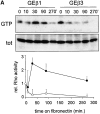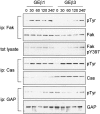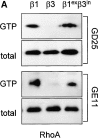The fibronectin-binding integrins alpha5beta1 and alphavbeta3 differentially modulate RhoA-GTP loading, organization of cell matrix adhesions, and fibronectin fibrillogenesis
- PMID: 12486108
- PMCID: PMC2173988
- DOI: 10.1083/jcb.200205014
The fibronectin-binding integrins alpha5beta1 and alphavbeta3 differentially modulate RhoA-GTP loading, organization of cell matrix adhesions, and fibronectin fibrillogenesis
Abstract
We have studied the formation of different types of cell matrix adhesions in cells that bind to fibronectin via either alpha5beta1 or alphavbeta3. In both cases, cell adhesion to fibronectin leads to a rapid decrease in RhoA activity. However, alpha5beta1 but not alphavbeta3 supports high levels of RhoA activity at later stages of cell spreading, which are associated with a translocation of focal contacts to peripheral cell protrusions, recruitment of tensin into fibrillar adhesions, and fibronectin fibrillogenesis. Expression of an activated mutant of RhoA stimulates alphavbeta3-mediated fibrillogenesis. Despite the fact that alpha5beta1-mediated adhesion to the central cell-binding domain of fibronectin supports activation of RhoA, other regions of fibronectin are required for the development of alpha5beta1-mediated but not alphavbeta3-mediated focal contacts. Using chimeras of beta1 and beta3 subunits, we find that the extracellular domain of beta1 controls RhoA activity. By expressing both beta1 and beta3 at high levels, we show that beta1-mediated control of the levels of beta3 is important for the distribution of focal contacts. Our findings demonstrate that the pattern of fibronectin receptors expressed on a cell dictates the ability of fibronectin to stimulate RhoA-mediated organization of cell matrix adhesions.
Figures





















Similar articles
-
Alpha4beta1 integrin/ligand interaction inhibits alpha5beta1-induced stress fibers and focal adhesions via down-regulation of RhoA and induces melanoma cell migration.Mol Biol Cell. 2003 Sep;14(9):3699-715. doi: 10.1091/mbc.e02-10-0667. Epub 2003 May 18. Mol Biol Cell. 2003. PMID: 12972558 Free PMC article.
-
ILK supports RhoA/ROCK-mediated contractility of human intestinal epithelial crypt cells by inducing the fibrillogenesis of endogenous soluble fibronectin during the spreading process.BMC Mol Cell Biol. 2020 Mar 17;21(1):14. doi: 10.1186/s12860-020-00259-0. BMC Mol Cell Biol. 2020. PMID: 32183701 Free PMC article.
-
Galectin binding to Mgat5-modified N-glycans regulates fibronectin matrix remodeling in tumor cells.Mol Cell Biol. 2006 Apr;26(8):3181-93. doi: 10.1128/MCB.26.8.3181-3193.2006. Mol Cell Biol. 2006. PMID: 16581792 Free PMC article.
-
Integrating actin dynamics, mechanotransduction and integrin activation: the multiple functions of actin binding proteins in focal adhesions.Eur J Cell Biol. 2013 Oct-Nov;92(10-11):339-48. doi: 10.1016/j.ejcb.2013.10.009. Epub 2013 Nov 4. Eur J Cell Biol. 2013. PMID: 24252517 Review.
-
Tensins are versatile regulators of Rho GTPase signalling and cell adhesion.Biol Cell. 2017 Mar;109(3):115-126. doi: 10.1111/boc.201600053. Epub 2016 Nov 25. Biol Cell. 2017. PMID: 27748980 Review.
Cited by
-
Microtubule-dependent modulation of adhesion complex composition.PLoS One. 2014 Dec 19;9(12):e115213. doi: 10.1371/journal.pone.0115213. eCollection 2014. PLoS One. 2014. PMID: 25526367 Free PMC article.
-
Cancer-associated fibroblasts drive the progression of metastasis through both paracrine and mechanical pressure on cancer tissue.Mol Cancer Res. 2012 Nov;10(11):1403-18. doi: 10.1158/1541-7786.MCR-12-0307. Epub 2012 Sep 28. Mol Cancer Res. 2012. PMID: 23024188 Free PMC article. Review.
-
The RGD motif in fibronectin is essential for development but dispensable for fibril assembly.J Cell Biol. 2007 Jul 2;178(1):167-78. doi: 10.1083/jcb.200703021. Epub 2007 Jun 25. J Cell Biol. 2007. PMID: 17591922 Free PMC article.
-
RGD-independent cell adhesion via a tissue transglutaminase-fibronectin matrix promotes fibronectin fibril deposition and requires syndecan-4/2 α5β1 integrin co-signaling.J Biol Chem. 2010 Dec 17;285(51):40212-29. doi: 10.1074/jbc.M110.123703. Epub 2010 Oct 7. J Biol Chem. 2010. PMID: 20929862 Free PMC article.
-
Reappraising the role of α5 integrin and the microenvironmental support in stress erythropoiesis.Exp Hematol. 2020 Jan;81:16-31.e4. doi: 10.1016/j.exphem.2019.12.004. Epub 2019 Dec 28. Exp Hematol. 2020. PMID: 31887343 Free PMC article.
References
-
- Aota, S., M. Nomizu, and K. Yamada. 1994. The short amino acid sequence Pro-His-Ser-Arg-Asn in human fibronectin enhances cell-adhesive function. J. Biol. Chem. 269:24756–24761. - PubMed
-
- Arthur, W., L. Petch, and K. Burridge. 2000. Integrin engagement suppresses RhoA activity via a c-Src-dependent mechanism. Curr. Biol. 10:719–722. - PubMed
-
- Barry, S., H. Flinn, M. Humphries, D. Critchley, and A. Ridley. 1997. Requirement for Rho in integrin signalling. Cell Adhes. Commun. 4:387–398. - PubMed
-
- Berrier, A.L., R. Martinez, G.M. Bokoch, and S.L. LaFlamme. 2002. Integrin β tails activate Rac1. J. Cell Sci. 115:4285–4291 - PubMed
Publication types
MeSH terms
Substances
LinkOut - more resources
Full Text Sources
Other Literature Sources
Molecular Biology Databases
Miscellaneous

